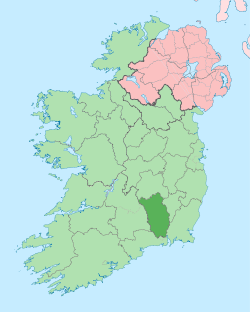Monastery of Inisnag
 Location within Ireland | |
| Monastery information | |
|---|---|
| Other names | Inis-Snaig, Ennisnag |
| Established | 6th century |
| Disestablished | 16 century |
| Dedicated to | Saint Manchan |
| Diocese | Diocese of Ossory |
| People | |
| Founder(s) | Saint Manchan |
| Site | |
| Location | County Kilkenny |
| Country |
|
| Coordinates | 52°33′12″N 7°14′08″W / 52.553214°N 7.2355099°W |
| Visible remains | no trace |
| Public access | Yes |
The Monastery of Inisnag (otherwise Ennisnag, Irish: Inis Snaig, MidEng: Inisnag, meaning "the Island, or Islet, of the Crane, or Heron"), was an early Irish Christian monastery, and later a medieval prebend church, located at Ennisnag, in County Kilkenny, Ireland. The medieval monastery, and church, are no longer extant. From the ruins, St Peters church, of Protestant denomination, was established in the early 19th century..
Monastery of Inis-Snaig
Little is known about the monastic community here. Canon William Carrigan suggested "an ancient Church stood on the site from time immemorial to after the Cromwellian era".[1] O'Hanlon, studying Ossory ecclesiastical records, confirms an ancient link between the establishment of the Christian settlement, and Saint Manchan, declaring- "at Inisnag, diocese of Ossory, St. Manchan, whose feast occurs on the 14th of February, was venerated as a patron (Statuta Dioecesis Ossoriensis)",[2] dating it's foundation to fifth, or early sixth century. Modern tradition names Máedóc of Ferns as patron saint of Ennisnag, and his "feast day was celebrated here on the 14th of February",[1][n 1] His holy well, otherwise called Irish: Tobair Mogue, is preserved.[1] The monastery of Inis-Snaig was probably relatively small in scale.
The Annals of the Four Masters has an entry for AD745, recalling the "battle of Inis Snaig", between "Anmchaidh mac Cucearca", king of Osraighe, and an unknown opponent,[3] and an entry for AD 889, "the death of "Suadhbhar mac Coitceadhach, of Inis Snaig, died an anchorite",[4] confirming the early Christian Irish monastery of Inis Snaig flourished in at least the ninth century, but probably from the early middle ages to sometime before, or after, the Norman invasion of the 12th century.[5]
Prebend of Inisnag
The church of Inisnag was recorded as prebend of Ossory diocese, in the Taxatio Ecclesiastica of AD1291-1292. The Treasurer of the Diocesan Chapter of Ossory, possessed the prebendal of Ennisnag from the 15th century. This Diocesan Chapter, consisted of a Dean, Archdeacon, Chancellor, precentor and Treasurer, is traceable back to Felix O' Dulaney (1178-1202), the late 12th century onwards. The prebendal church of Ennisnag is included in the list of churchs, or parishes, possessed by ecclesticals of the Diocesan Chapter of Ossory, right down to the Protestant Reformation of the 16th century. According to a papal document titled "Ecllesial De Inisnage Prebend -£ ix.", preserved by the Protestant Bishop of Ossory, with Rev. James Graves once holding a correct transcript of same, the prebend of Inisnag was granted on "the authority of Pope Nicholas IV, 1291 [liber ruber Ossoriensis]".[1]
The medieval church fell into ruins after the Dissolution of the Monasteries, and upheaval's of 17th century Ireland.
Abbots and prebends
|
It is impossible to fully catalogue the succession of Abbots, and Prebendary holders. Nonetheless, the information below is preserved, or inferred. Floruit abbreviations used for dates:
St Peter'sIn the 19th century, a Protestant church was constructed on this old church site, named St. Peter's Church, Ennisnag, Kilkenny. See alsoNotes and referencesNotes
Citations
Primary sources
Secondary sources
External links |
